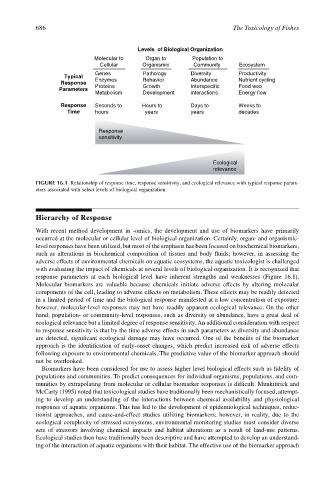Page 706 - The Toxicology of Fishes
P. 706
686 The Toxicology of Fishes
Levels of Biological Organization
Molecular to Organ to Population to
Cellular Organismic Community Ecosystem
Genes Pathology Diversity Productivity
Typical
Response Enzymes Behavior Abundance Nutrient cycling
Parameters Proteins Growth Interspecific Food web
Metabolism Development interactions Energy flow
Response Seconds to Hours to Days to Weeks to
Time hours years years decades
Response
sensitivity
Ecological
relevance
FIGURE 16.1 Relationship of response time, response sensitivity, and ecological relevance with typical response param-
eters associated with select levels of biological organization.
Hierarchy of Response
With recent method development in -omics, the development and use of biomarkers have primarily
occurred at the molecular or cellular level of biological organization. Certainly, organ- and organismic-
level responses have been utilized, but most of the emphasis has been focused on biochemical biomarkers,
such as alterations in biochemical composition of tissues and body fluids; however, in assessing the
adverse effects of environmental chemicals on aquatic ecosystems, the aquatic toxicologist is challenged
with evaluating the impact of chemicals at several levels of biological organization. It is recognized that
response parameters at each biological level have inherent strengths and weaknesses (Figure 16.1).
Molecular biomarkers are valuable because chemicals initiate adverse effects by altering molecular
components of the cell, leading to adverse effects on metabolism. These effects may be readily detected
in a limited period of time and the biological response manifested at a low concentration of exposure;
however, molecular-level responses may not have readily apparent ecological relevance. On the other
hand, population- or community-level responses, such as diversity or abundance, have a great deal of
ecological relevance but a limited degree of response sensitivity. An additional consideration with respect
to response sensitivity is that by the time adverse effects in such parameters as diversity and abundance
are detected, significant ecological damage may have occurred. One of the benefits of the biomarker
approach is the identification of early-onset changes, which predict increased risk of adverse effects
following exposure to environmental chemicals. The predictive value of the biomarker approach should
not be overlooked.
Biomarkers have been considered for use to assess higher level biological effects such as fidelity of
populations and communities. To predict consequences for individual organisms, populations, and com-
munities by extrapolating from molecular or cellular biomarker responses is difficult. Munkittrick and
McCarty (1995) noted that toxicological studies have traditionally been mechanistically focused, attempt-
ing to develop an understanding of the interactions between chemical availability and physiological
responses of aquatic organisms. This has led to the development of epidemiological techniques, reduc-
tionist approaches, and cause-and-effect studies utilizing biomarkers; however, in reality, due to the
ecological complexity of stressed ecosystems, environmental monitoring studies must consider diverse
sets of stressors involving chemical impacts and habitat alterations as a result of land-use patterns.
Ecological studies then have traditionally been descriptive and have attempted to develop an understand-
ing of the interaction of aquatic organisms with their habitat. The effective use of the biomarker approach

